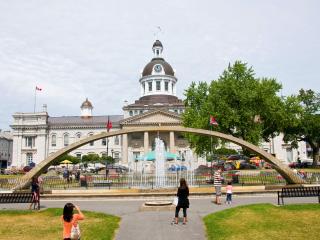
Kingston, Ontario
A Community Impact Story
Tourism Kingston: No Food Wasted: A Stewardship-Driven Approach to Food Recovery
Social Impact Framework: Health and Wellbeing

What was the issue you were trying to address?
In Kingston, we identified a growing concern around food waste and food accessibility. These two issues directly impact the well-being of our residents. As a destination that regularly hosts large-scale events, we saw firsthand how much food was going to waste and were mindful of the food insecurity that persists in our community. We knew we had a responsibility to do better. By tackling food waste at its source and redirecting usable food to those in need, we could enhance not only environmental sustainability, but also social equity and community health.
What were the stated objectives of this initiative?
Our primary goal was simple yet ambitious: that no food should go to waste at any event in Kingston. We are committed to building this into our broader stewardship strategy, embedding food recovery as a core value for Tourism Kingston. Beyond reducing waste, we wanted to ensure that surplus food can be reclaimed, repurposed, and redistributed in ways that benefit all. By aligning our events with community well-being and environmental impact, we aimed to create a model for regenerative tourism.
What were the specific metrics you used to measure the success of your efforts?
We conducted a testing period throughout 2024. To evaluate our progress, we tracked several key metrics including:
- The number of events participating in food recovery efforts
- The number of donating partners involved
- The amount of food reclaimed, measured both in weight and dollar value
- The number of meals distributed to the community
- The volume of food redistributed or repurposed, again by weight and value
- And importantly, the emissions avoided from food decomposition, measured in metric tons of CO₂e
These metrics helped us understand not just the operational scale of the initiative, but also the environmental and social benefits that came from reclaiming what would otherwise be wasted.
What were the specific outcomes and results of your efforts?
During our 2024 testing period, the results were both inspiring and affirming.
We rescued $3.4 million worth of food. This economic impact reinforces our belief that food recovery can be a cornerstone of destination stewardship.
We successfully diverted 601,512 pounds of food from landfills. 88,422 pounds of food unsuitable for human redistribution were donated to local farmers for animal feed, ensuring nothing was wasted. 513,090 pounds of food were either redistributed or repurposed into nutritious meals.
Environmentally, the initiative prevented 825 metric tons of CO₂e from entering the atmosphere, the equivalent of removing 203 passenger vehicles from the road for an entire year.
What other best practices or key lessons can you share?
If there’s one thing we’ve learned, it’s that when you bring together a dedicated team of people who care, incredible things are possible. The amount of food we rescued and redistributed is real, measurable, and deeply impactful. Collaboration between event organizers, community partners, farmers, and volunteers made this initiative viable and powerful.
This work has shown us that food recovery doesn’t have to be a side project: it can be central to how a destination defines sustainability and community impact. By embedding these efforts into our event strategy, we’ve moved beyond recycling bins and carbon offsets. We’re feeding people, helping farmers, and cutting emissions. And we’re showing that a well-fed community and a well-run event can go hand in hand.
